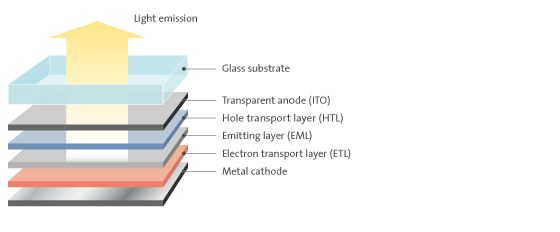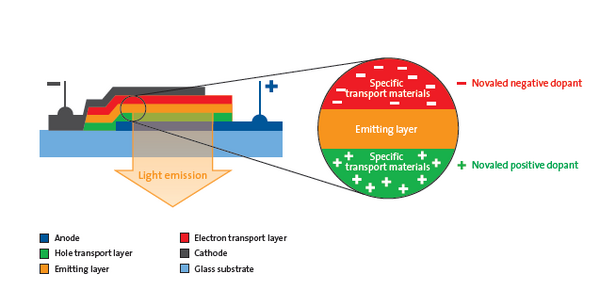OLEDs – how do they work?
OLEDs consist of several functional layers, including charge transport and emissive layers. Novaled’s unique approach uses doping materials to increase the conductivity of the charge transport layers. OLEDs with these materials exhibit low voltage and stable operation, resulting in durable and power-saving OLED products.
Main parts of an OLED
substrate, anode, cathode and organic layers (transport + emissive layer)

Function
As current flows from the cathode to the anode through the organic layers, holes and electrons move from the corresponding conducting layers into the emissive layer where they recombine. As the electrons drop into the holes, they release extra energy as light, thus generating an organic light source.

ノバレッド®ドーピング技術の動作原理
- アノードから正孔を注入し、p型正孔輸送層(p-HTL)を経由し、発光層(EML)に到達
- カソードから電子を注入し、n型電子輸送層(n-ETL)を経由
- 発光層で電荷キャリアを再結合させ、発光
- ノバレッドは、p-HTLとn-ETLのドーパント材料および輸送材料を提供

Novaled® 도핑 기술의 원리
- 양극에서 정공이 주입되고, p도핑된 정공 수송층( p-HTL)이 이를 발광층(EML)으로 수송한다.
- 음극에서 전자가 주입되고, n-도핑된 전자 수송층(n-ETL)이 이를 수송한다.
- EML에서 전하 수송체의 재결합이 발생하고 빛이 발산된다.
- p-HTL와 n-ETL용 도펀트(dopant)와 주 소재는 Novaled 가 제공한다.
OLEDs are
- OLEDs are solid-state devices composed of multiple thin layers of organic materials with in total just 1/50th the thickness of a human hair.
- different than LEDs or other point light sources.
OLEDs emit diffuse light as an area light source
when electricity is applied.